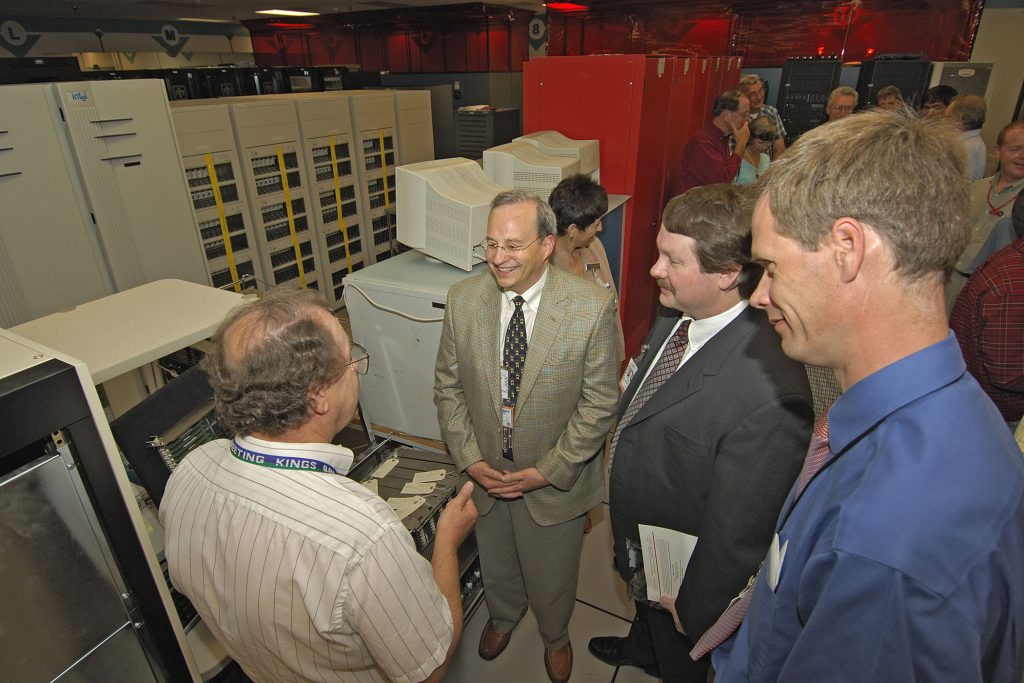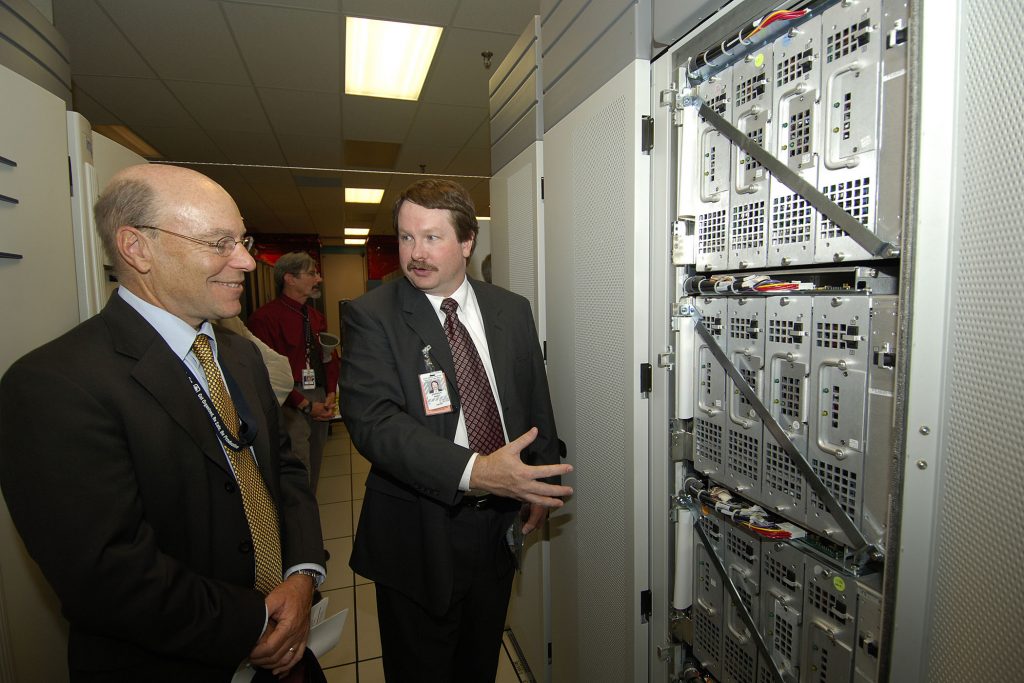
ALBUQUERQUE, N.M. — On a table in a small meeting room at Sandia National Laboratories rested a picture of the deceased — a row of identical cabinets that formed part of the entity known as ASCI Red, the world’s first teraflop supercomputer.
Still one of the world’s 500 fastest supercomputers after all these years — nine — ASCI Red was being decommissioned.
“I’ve never buried a computer before,” said Justin Rattner, Intel Chief Technology Officer, to 30 people from Sandia and the Intel Corp. who gathered in mid-June to pay their respects. “We should go around the room so everyone can say their final farewells.”
On a nearby table sat a simple white frosted cake. Encircled top and bottom by two strings of small simulated pearls and topped by pink flowers and a silver ribbon, it resembled a hat that could be worn by a very elderly lady, and indeed, ASCI Red was very old by supercomputer standards.
Sandia vice-president Rick Stulen eulogized, “ASCI Red broke all records and most importantly ushered the world into the teraflop regime. It still holds the record for the longest continuous rating as the world’s fastest computer, four years running.”
A teraflop represents a trillion mathematical operations per second.
Sandia is a National Nuclear Security Administration laboratory.

ASCI Red was a critical part of NNSA’s Advanced Simulation and Computing (ASC) program. The computer simulation capabilities developed by the ASC program, and conducted on supercomputers like ASCI Red, provide the nuclear weapons and materials analysis that NNSA needs to keep the nuclear weapons stockpile safe, secure and reliable without underground nuclear testing.
ASCI Red first broke the teraflops barrier in December, 1996 and topped the world-recognized LINPAC top-500 computer speed ratings seven consecutive times from June 1997 to June 2000.
Originally rated at 1.6 teraflops, a chip upgrade raised it to 3.1 t-flops just when it looked as though its world supremacy would be lost.
It remains, nine years after it was first turned on, still one of the 500 fastest computers in the world.
Sandia director Bill Camp said that ASCI Red had the best reliability of any supercomputer ever built, and “was supercomputing’s high-water mark in longevity, price, and performance.”
“It was almost mystical in scalability,” said another Sandia director, Rob Leland. “All these other machines would be tailing off and Red would still be cruising along,”
Said Rattner, “There’s a sense of sadness and also of satisfaction: the passing of such a great machine and the incredible affection so many of you show for this inanimate object that occupies this floor space.”

Rattner gave some insight into the general feeling about what was, after all, only a machine when he spoke about his own emotions when ASCI Red proved successful. “I remember, shortly after the teraflops barrier was broken,” he told the assembled mourners, “I would say to myself as I drove by in my car: the world’s fastest computer is sitting in that nondescript building [in Beaverton, Oregon, before it was moved to Sandia]. It gave me tremendous satisfaction. When Chuck Yeager cracked the sound barrier or Armstrong landed on the moon, I wonder if they had the same feeling. It is with great fondness that we say goodbye to ASCI Red. It’s been a great run and we’ll never forget it.”
Stephen Wheat, a former Sandian who went over to Intel to help design the computer, said that the chip was a third-generation chip, and so the design was accomplished in only three months with great reliability. After that, Intel got out of the supercomputer business so as not to compete with customers who might want to enter.
“An indication of how good the reliability was,” said Sandia computer designer Jim Tomkins, “was that the hardware reliability remained the same when Sandia took it over from Intel.”
The idea for the machine in the first place, as well as the programs that ran the computer near-flawlessly, were developed by Sandia over nearly a decade of leadership in multiple parallel-processing machines — individual computer processors programmed to act in concert with each other.
“When we first talked about running a machine with 10,000 processors, it seemed ludicrous,” Rattner said, apparently anticipating massive downtimes. But instead of 27 hours average time between hardware-caused interrupts — the figure predicted in the design phase — Red achieved an average of several hundreds hours.
Sandia researcher Michael Hannah,till 2002 charged with keeping the machine running, emphasized that the machine was not being decommissioned because of technical problems. “It’s not a reliability issue, because ASCI Red is still reliable,” he said. “It is about getting more bang for the buck with nine-year-newer technology and terminating significant costs in space, power, and cooling.”
Jammed into the same small air-cooled building were other supercomputers, including Sandia’s Thunderbird capacity supercomputer, running at approximately 60 teraflops. In a new building, next door was Red Storm, clipping along at roughly 40 t-flops.
“Having so many machines in so little space keeps us innovative,” says Sandia manager Archie Gibson.